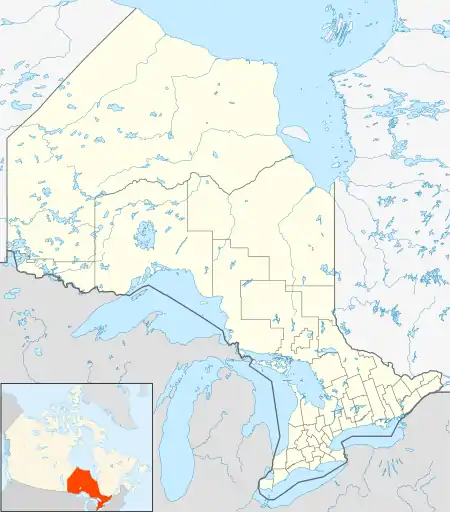Hearst, Ontario
Hearst is a town in the district of Cochrane, Ontario, Canada.[2][3] It is located on the Mattawishkwia River in Northern Ontario, approximately 92 kilometres (57 mi) west of Kapuskasing, approximately 935 kilometres (581 mi) north of Toronto and 520 kilometres (320 mi) east of Thunder Bay along Highway 11. At Hearst, Highway 583 extends northward to Lac-Sainte-Thérèse and southward to Jogues, Coppell and Mead.
Hearst | |
|---|---|
| Town of Hearst Ville de Hearst (French) | |
 | |
 Hearst | |
| Coordinates: 49°41′13″N 83°39′16″W | |
| Country | Canada |
| Province | Ontario |
| District | Cochrane |
| Established | 1913 |
| Government | |
| • Type | Town |
| • Mayor | Roger Sigouin |
| • Governing Body | Hearst Town Council |
| • MP | Carol Hughes (NDP) |
| • MPP | Guy Bourgouin (NDP) |
| Area | |
| • Land | 98.52 km2 (38.04 sq mi) |
| Population (2016)[1] | |
| • Total | 5,070 |
| • Density | 51.5/km2 (133/sq mi) |
| Time zone | UTC-5 (EST) |
| • Summer (DST) | UTC-4 (EDT) |
| Postal code FSA | P0L |
| Area code(s) | 705 |
| GNBC Code | FBMTW[2] |
| Website | www.hearst.ca |
History
.jpg.webp)
The town came into being due to the construction of the National Transcontinental Railway in 1913. Established as a divisional point, Hearst is 208 km west of Cochrane and 201 km east of the divisional point of Grant. There is some historical ambiguity with the name Grant as the original site of Hearst was also called Grant and was changed to Hearst in 1911.
Hearst was named to honour William Howard Hearst, then Ontario Minister of Forests and Mines and later Premier of Ontario.[4] It was incorporated in 1922. Many settlers to the town originally came from the province of Quebec. Many also came from Europe and other regions in Canada and the USA.
Demographics
| Canada census – Hearst, Ontario community profile | |||
|---|---|---|---|
| 2016 | 2011 | 2006 | |
| Population: | 5,070 (-0.4% from 2011) | 5,090 (-9.4% from 2006) | 5,620 (-3.5% from 2001) |
| Land area: | 98.52 km2 (38.04 sq mi) | 98.73 km2 (38.12 sq mi) | 98.67 km2 (38.10 sq mi) |
| Population density: | 51.5/km2 (133/sq mi) | 51.6/km2 (134/sq mi) | 57.0/km2 (148/sq mi) |
| Median age: | 47.9 (M: 47.4, F: 48.3) | 45.1 (M: 44.8, F: 45.5) | 41.5 (M: 40.8, F: 42.1) |
| Total private dwellings: | 2,466 | 2,401 | 2,547 |
| Median household income: | $64,064 | $56,897 | |
| References: 2016[5] 2011[6] 2006[7] earlier[8] | |||
|
| |||||||||||||||||||||||||||||||||
| [9][10][1] | ||||||||||||||||||||||||||||||||||
Economy

Hearst has a long tradition of being a "lumber town". Currently the major employers include a Tembec hardwood and softwood facility as well as a plywood mill operated by Columbia Forest Products.
Arts and culture
93.7% of Hearst's population is francophone.[11] Different cultures can be found in Hearst such as Finn, Slovak, Bulgarian, Chinese, Portuguese, Greek, Ukrainian, First Nations and also Black Canadians.
The town is home to the Université de Hearst, a federated school of Laurentian University in Sudbury. The Hearst Public Library was founded on December 17, 1974. In its beginning, the library was situated in the basement of the Hearst High School where it shared its space with the school library. On June 4, 1984, the library moved to its present location, 801 George Street (formerly Stedman's). Hearst is a four-season destination. Many years ago, the town proclaimed itself the Moose Capital of Canada.[12] Local outdoor activities include fishing, hunting, snowmobiling, cross-country skiing, camping, swimming, canoeing, and golf.
Infrastructure
Transportation
Hearst is served by Hearst (René Fontaine) Municipal Airport.
Hearst was the northern terminus for a Canadian National Railways-operated passenger train service from Sault Ste. Marie, Ontario, running over the tracks of the former Algoma Central Railway.[11] Hearst is the northern terminus for Ontario Northland's coach service.
Education

Hearst has both elementary and high schools (public and Catholic). It also has the Université de Hearst, a post-secondary institution federated with Laurentian University in Sudbury. Education can also be sought at the collegiate level with the Collège Boréal.
Media
Hearst's only local newspaper service is provided by Le Nord.
Radio
Hearst's only local radio service is provided by CINN-FM, a community radio station. All other radio stations available in the community are rebroadcasters of stations from Kapuskasing, Timmins or Sudbury.
| Frequency | Call sign | Branding | Format | Owner | Notes |
|---|---|---|---|---|---|
| FM 90.3 | CBON-FM-26 | Ici Radio-Canada Première | Talk radio, public radio | Canadian Broadcasting Corporation | Rebroadcaster of CBON-FM (Sudbury) |
| FM 91.1 | CINN-FM | CINNFM 91.1 | Community radio | Radio de l'Épinette Noire | Franco-Ontarian community radio |
| FM 91.9 | CBCC-FM | CBC Radio One | Talk radio, public radio | Canadian Broadcasting Corporation | Rebroadcaster of CBCS-FM (Sudbury) |
| FM 92.9 | CHYK-FM-3 | Le Loup | French hot adult contemporary | Le5 Communications | Rebroadcaster of CHYK-FM (Timmins) |
| FM 94.5 | CKHT-FM | Moose FM | Adult contemporary | Vista Broadcast Group | Rebroadcaster of CKAP-FM (Kapuskasing) |
Television
| OTA channel | Call sign | Network | Notes |
|---|---|---|---|
| 4 (VHF) | CITO-TV-3 | CTV | Rebroadcaster of CITO-TV (Timmins); de fact rebroadcaster of CICI-TV (Sudbury) |
Hearst was previously served by CBCC-TV and CBLFT-TV-5, rebroadcasters of the Toronto-based CBLT-DT (CBC Television) and CBLFT-DT (Ici Radio-Canada Télé) respectively, but the transmitters were shut down in 2012 due to budget cuts at the Canadian Broadcasting Corporation.
Notable people
- Réginald Bélair, politician[13]
- René Fontaine, politician. Hearst (René Fontaine) Municipal Airport is named in his honour.[14]
- Doric Germain, writer whose books centre on Franco-Ontarian heritage
- Claude Giroux, professional hockey player
- Claude Larose, professional hockey player
- Rumun Ndur, professional hockey player
- Eric Sorensen, journalist
- Pierre LeBrun, journalist
References
- "Hearst census profile". 2016 Census of Population. Statistics Canada. Retrieved 2012-02-17.
- "Hearst". Natural Resources Canada. October 6, 2016.
- "Hearst". Statistics Canada. November 2, 2016.
- "'The Honourable Sir William Howard Hearst (Premier 1914-1919)'". Archived from the original on 2011-06-15. Retrieved 2010-10-18.
- "2016 Community Profiles". 2016 Canadian Census. Statistics Canada. February 21, 2017. Retrieved 2019-06-11.
- "2011 Community Profiles". 2011 Canadian Census. Statistics Canada. July 5, 2013. Retrieved 2012-02-17.
- "2006 Community Profiles". 2006 Canadian Census. Statistics Canada. March 30, 2011. Retrieved 2012-02-17.
- "2001 Community Profiles". 2001 Canadian Census. Statistics Canada. February 17, 2012.
- 143.pdf, Canada Year Book 1955
- 191.pdf, Canada Year Book 1967
-
"The French Connection with a local twist". Soo Today. 2013-08-30. Archived from the original on 2013-09-03. Retrieved 2013-09-03.
Why go to Quebec to speak French when you can hop on the Algoma Central train to the 95 percent francophone city of Hearst - 96 miles north of the Sault!
- Northern Ontario - Hearst, Ontario - James Bay Frontier
- "Réginald Bélair". Parliament of Canada. Retrieved September 10, 2018.
- "Hearst's Rene Fontaine Dies". Northern Ontario Business. March 26, 2012.
